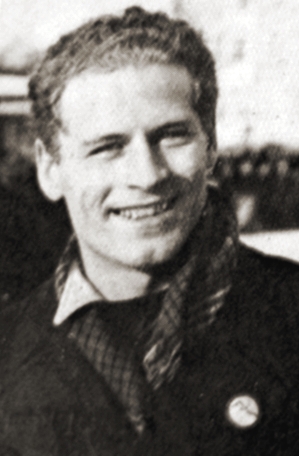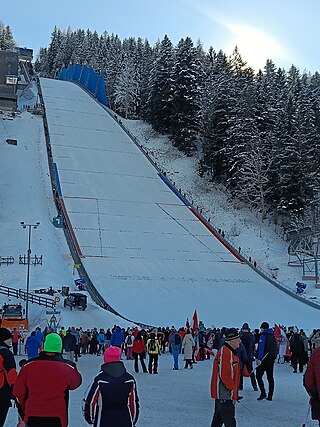
Ski jumping is a winter sport in which competitors aim to achieve the farthest jump after sliding down on their skis from a specially designed curved ramp. Along with jump length, competitor's aerial style and other factors also affect the final score. Ski jumping was first contested in Norway in the late 19th century, and later spread through Europe and North America in the early 20th century. Along with cross-country skiing, it constitutes the traditional group of Nordic skiing disciplines.

Holmenkollbakken is a large ski jumping hill located at Holmenkollen in Oslo, Norway. It has a hill size of HS134, a construction point of K-120, and a capacity for 70,000 spectators. Holmenkollen has hosted the Holmenkollen Ski Festival since 1892, which since 1980 have been part of the FIS Ski Jumping World Cup and 1983 the FIS Nordic Combined World Cup. It has also hosted the 1952 Winter Olympics and the FIS Nordic World Ski Championships in 1930, 1966, 1982 and 2011.

The FIS Nordic World Ski Championships is a biennial Nordic skiing event organized by the International Ski Federation (FIS). The World Championships was started in 1925 for men and opened for women's participation in 1954. World Championship events include Nordic skiing's three disciplines: cross-country skiing, ski jumping, and Nordic combined. From 1924 to 1939, the World Championships were held every year, including the Winter Olympics. After World War II, the World Championships were held every four years from 1950 to 1982. Since 1985, the World Championships have been held in odd-numbered years.

Stanisław Marusarz ; 18 June 1913 – 29 October 1993) was a Polish Nordic skiing competitor in the 1930s.

Lysgårdsbakken, officially known as Lysgårdsbakkene Ski Jumping Arena, is a ski jumping hill in Lillehammer, Norway. It consists of a large hill, with a K-point of 123 and a hill size of 138, and a small hill with a K-point of 90 and a hill size of 98. It opened in 1993 for the 1994 Winter Olympics, where it hosted the ski jumping and Nordic combined events, as well as the opening and closing ceremonies. After the Olympics, ownership was transferred to the municipal Lillehammer Olympiapark and it has since been used for several FIS Ski Jumping World Cup and FIS Nordic Combined World Cup tournaments, including hosting the Nordic Tournament. It has a capacity for 35,000 spectators and is one of three national ski jumping hills in Norway. In 2007, the large hill was rebuilt to a larger profile, and received a new plastic lining. The venue sees 80,000 annual jumps in the winter and 20,000 in the summer season.
Andreas Felder is an Austrian former ski jumper. During this period he dominated the sport, together with contemporaries Jens Weißflog and Matti Nykänen. He finished in the top three overall six times in the World Cup and won the 1990/91 overall. He won his first international championship medal at the 1982 FIS Nordic World Ski Championships in Oslo with a silver medal in the team large hill event.

Armin Kogler is an Austrian former ski jumper.

Anton Innauer is an Austrian former ski jumper.

Kulm is a ski flying hill located in Tauplitz/Bad Mitterndorf, Styria, Austria opened in 1950.
The men's normal hill individual ski jumping competition for the 2010 Winter Olympics in Vancouver, Canada was held on 12 and 13 February 2010 at Whistler Olympic Park in Whistler, British Columbia. It was the first medal event of the 2010 Games.

Peter Prevc is a Slovenian ski jumper. He won the 2016 Ski Jumping World Cup overall title and four Olympic medals, including gold at the 2022 Winter Olympics in the mixed team event. He also won the 2016 Four Hills Tournament, 2016 Ski Flying World Championships, and three consecutive Ski Flying World Cup overall titles. In addition, Prevc won two team events with the Slovenia national team at the Ski Flying World Championships, in 2022 and 2024.

For the 1980 Winter Olympics in Lake Placid, New York, United States, a total of seven sports venues were used. All five of the venues used for the 1932 Winter Olympics were also used at the 1980 Winter Games with adjustments. These adjustments included electronic scoreboards, increased refrigeration, and the addition of a separate luge track. This was the last Winter Olympics where there were separate bobsleigh and luge tracks. The closest finish in Olympic history in cross-country skiing led skiing officials to time future events in hundredths of a second rather than tenths of a second. This would also apply to biathlon events. Eric Heiden won five gold medals at the speed skating oval while the "Miracle on Ice" took place between Americans and Soviets at the Olympic Center. In the late 1990s, the luge track was demolished and a new combination track was constructed in time for the only Winter Goodwill Games held. The sliding venue was named to the American National Register of Historical Places in February 2010.

Igman Olympic Jumps, also known as Malo Polje, is a defunct ski jumping hill on the mountain of Igman in Ilidža, Sarajevo, Bosnia and Herzegovina. It consists of a large hill with a construction point (K-point) of 112 meters (367 ft) and a normal hill with a K-point of 90 meters (295 ft). Construction started in 1980 and the venue opened in 1982 to host ski jumping and Nordic combined at the 1984 Winter Olympics. The large hill event saw Finland's Matti Nykänen set the hill record of 116.0 meters (381 ft) in front of 90,000 spectators. No other International Ski Federation (FIS) sanctioned competitions have taken place at the hills. During the Siege of Sarajevo, the hills became a battleground and have since not been used. However, there are plans to rebuild the in-run, expand the large hill and build new spectator stands and visitor facilities.
The 2021/22 FIS Ski Jumping Continental Cup was the 31st in a row Continental Cup winter season in ski jumping for men and the 18th for women. This was also the 20th summer continental cup season for men and 13th for women.
Lovro Kos is a Slovenian ski jumper.
The 2022–23 FIS Ski Jumping World Cup was the 44th World Cup season in ski jumping for men, the 26th official World Cup season in ski flying, and the 12th World Cup season for women. The men's season was the longest in the World Cup history; it started in November 2022 in Wisła, Poland and concluded in April 2023 in Planica, Slovenia. The women's season also started in Wisła and concluded in Lahti, Finland.
The 2022/23 FIS Ski Jumping Continental Cup was the 32nd Continental Cup winter season in ski jumping for men and the 19th for women. This is also the 21st summer continental cup season for men and 14th for women.
The 2023–24 FIS Ski Jumping Continental Cup, organized by the International Ski Federation (FIS) is the 33rd Continental Cup winter season and the 22nd Summer Continental Cup season in ski jumping for men.
The 2023–24 FIS Ski Jumping World Cup, organized by the International Ski Federation (FIS) is the 45th World Cup season in ski jumping for men, the 27th season in ski flying, and the 13th season for women.














